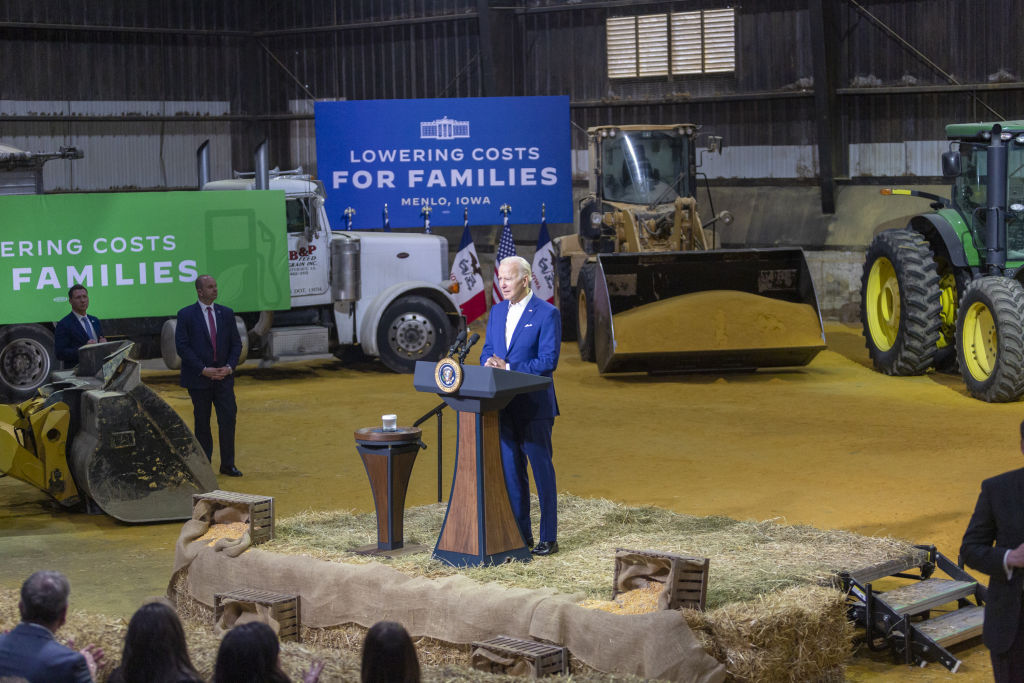
Corn farmers and the rest of the ethanol industry have been getting a lot of good news from Washington over the past few months. The most recent win is buried in the Inflation Reduction Act: $500 million for infrastructure to help sell higher ethanol-content gasoline at fuel stations. Now, industry allies in Congress are trying to capitalize on the momentum, pushing sweeping rule changes that would lock in more ethanol production for decades to come.
But while ethanol proponents have touted the fuel as a way to lower gas prices and help tackle climate change, many environmentalists and scientists say those measures are just a way of locking in higher corn prices while actually making the climate situation worse.
Rising fuel costs this spring due to Russia’s invasion of Ukraine, pandemic-spurred supply chain challenges, increased demand, and other market factors were a boon to ethanol proponents, who point to increased biofuel production as a way to lower gas prices. “They do feel emboldened given those factors,” says David DeGennaro, a policy analyst at the National Wildlife Federation. “[They] see that as a way to push for what they’ve been pushing for for a while now.” In April, President Joe Biden allowed gas stations to blend up to 15% ethanol into fuel they sell year round (up from the standard 10%)—a move intended to cut overall gasoline demand and lower the price at the pump. (The actual pricing effects of the policy, however, are likely quite small, as fewer than 2% of U.S. gas stations are equipped to offer 15% ethanol gasoline).
Then in June, the U.S. Department of Agriculture announced that it had paid $700 million dollars from the 2020 CARES Act funds to help ethanol and other biofuel producers impacted by the pandemic. The Inflation Reduction Act—which is heading to President Joe Biden’s desk to sign after passing both the Senate and House—adds yet another boost to the industry.
Farm state legislators across both parties are trying to keep up this wave of support. In recent weeks, some senators have worked to get fresh traction on a piece of legislation called the Next Generation Fuels Act of 2021. Introduced in the House last year by Illinois Democrat Cheri Bustos, the bill advances sweeping federal changes to require automakers to make all new gasoline-powered vehicles able to run on much higher proportions of ethanol. It also calls for new rules that would make gas stations sell much more ethanol nationwide.
Proponents of the legislation, like Senator Chuck Grassley (R. Iowa) who introduced the bill in the Senate last month, tout the move as a response to high fuel costs, and say it would lower carbon emissions. And while there’s a consensus among green transition planners that electrification, not alternative fuels, is the way forward for decarbonizing passenger vehicles, the ethanol industry says that batteries and ethanol are not necessarily at odds. “EVs are going to be a part of the strategy to achieve carbon neutrality,” says Geoff Cooper, president of the Renewable Fuels Association. “We’re simply arguing that ethanol and other renewable fuels should be another important part of that approach and the two should work together.”
Twenty years ago, environmentalists might have agreed; many environmental groups supported the 2000s-era push to start replacing gasoline with ethanol in the U.S. But today, there aren’t many in the movement who think conventional ethanol—mostly made from corn—has much to offer in terms of emissions reductions. Some emissions models show cuts of around 40% to lifecycle CO2 emissions when you compare corn ethanol to gasoline. But much of the research also points to an array of unintended consequences from years of wide-scale ethanol production. For instance, land use changes set off by pro-ethanol policy actually make the fuel about as bad, if not worse, than gasoline, according to a study published in February in the Proceedings of the National Academy of Sciences. That’s because laws encouraging ethanol consumption cause farmers to use more land for growing corn. When they till new fields to prepare for planting, they release carbon dioxide trapped in the soil.
“We have this industry that’s already built out, producing 14 billion gallons [of ethanol a year],” says Tyler Lark, a co-author on the study. “If that stays constant, there’s not as much of a cascade of impacts. Whereas, if this were to translate into expanding overall national corn demand, then we would be concerned that it could lead to higher crop prices, greater land use changes, and greater greenhouse gas emissions.”
It wasn’t supposed to be this way. Back in the 2000s, ethanol made from fermented corn was touted as a bridge fuel to more advanced cellulosic biofuels, which would turn entire plants into fuel, rather than just using their grain. That would lead to far less waste, and lower overall emissions. But those processes never took off at scale, leaving corn kernels, minus the stalks, cobs, and leaves, as the primary source of American ethanol to this day.
Corn growing trade groups have strongly supported the Next Generation Fuels Act, which sets required emissions reductions at such a level that they can still be met by using corn ethanol as opposed to more stringent requirements that would force a shift to more environmentally-friendly biofuels. “There’s still people working in [cellulosic biofuels],” says Aaron Smith, a professor of Agricultural Economics at the University of California Davis. “If we get a lot of that stuff, then, yeah, ethanol is good. But taking it from corn is not going to save us.”
More Must-Reads from TIME
- Cybersecurity Experts Are Sounding the Alarm on DOGE
- Meet the 2025 Women of the Year
- The Harsh Truth About Disability Inclusion
- Why Do More Young Adults Have Cancer?
- Colman Domingo Leads With Radical Love
- How to Get Better at Doing Things Alone
- Michelle Zauner Stares Down the Darkness
Write to Alejandro de la Garza at alejandro.delagarza@time.com